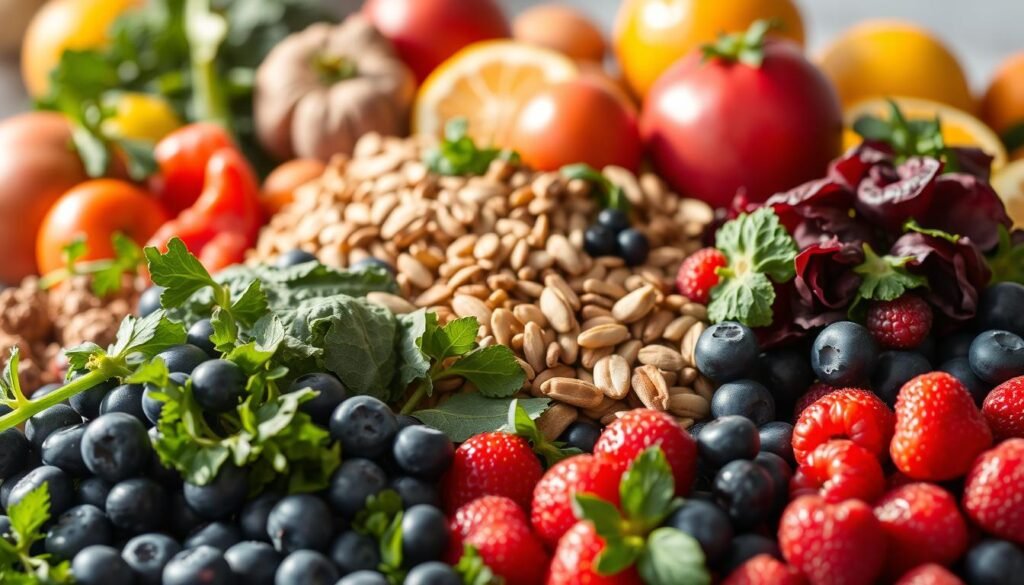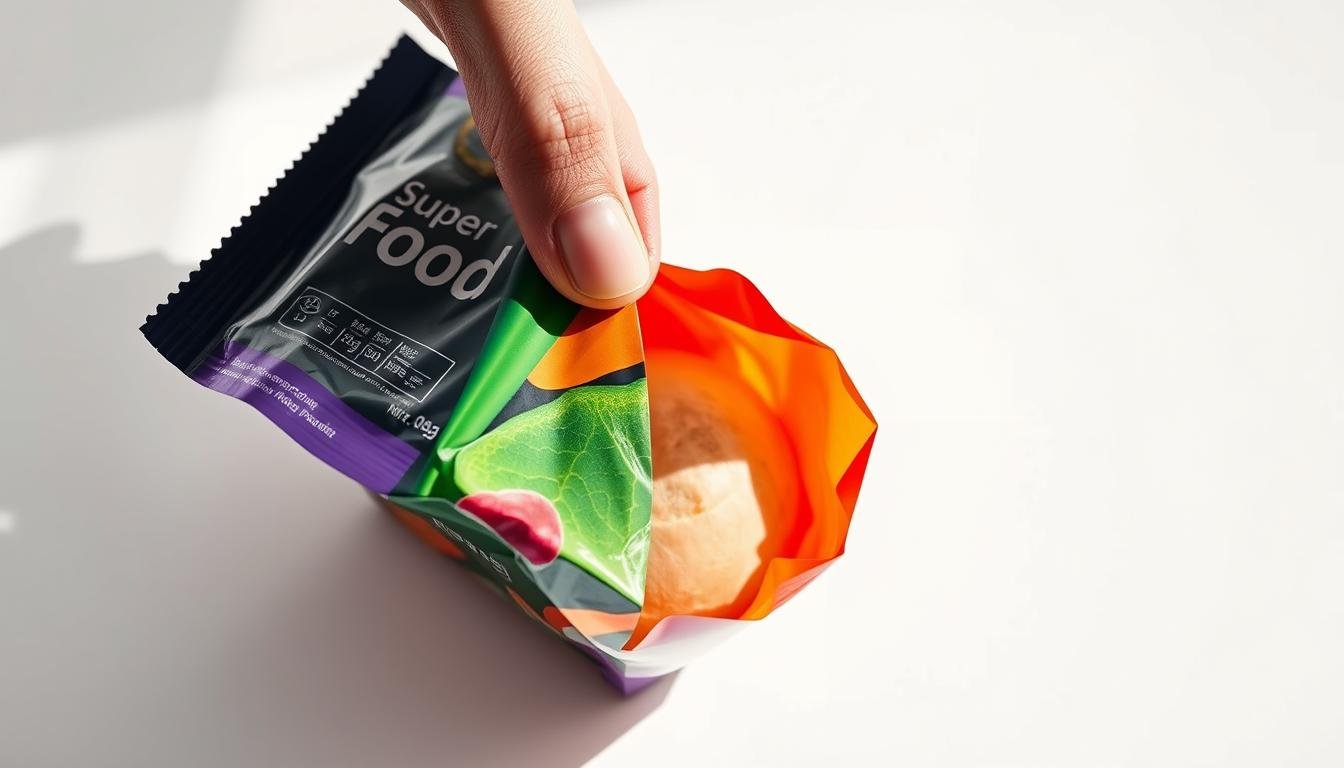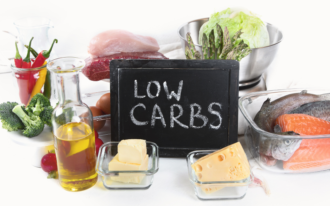I’ve spent years studying nutrition trends. I’m here to tell you the truth about superfoods. The global superfoods market reached $182 billion in 2023. It’s expected to hit $244 billion by 2030. That’s a huge amount of money for foods that are considered nutritional powerhouses.
The term “superfood” lacks a definitive scientific definition. It began over 100 years ago with a banana marketing campaign by The United Fruit Company. Today, superfood marketing myths use catchy labels to sell foods at high prices.
I aim to show you the real health benefits of the marketing hype. You’ll learn which foods are truly beneficial for you and which are just well-branded. My goal is to help you make smart choices with your nutrition budget.
For more evidence-based health tips, visit www.healthyvibeslife.com. Subscribe to our newsletter for practical wellness advice.
Key Takeaways
- The superfood market is worth over $182 billion, primarily driven by marketing
- “Superfood” originated as a 1920s banana marketing term with no official nutritional definition
- Many expensive superfoods offer similar benefits to common, affordable whole foods
- Marketing hype often exaggerates health claims beyond what research actually supports
- Smart consumers can achieve excellent nutrition without paying premium superfood prices
- Focus on overall dietary patterns, not individual “miracle” foods, for optimal health
🔍 What Makes a Food “Super” According to Science
What are superfoods?
My research into debunking superfood claims shows that real nutritional value isn’t always in the most expensive foods. Looking into the science, I see a big gap between what’s promised and what’s actually found.
The superfood market is huge, worth billions. But, no science group decides who gets to call a food “super”. This means companies can say almost any food is “super” without strict standards.
Defining Nutrient Density vs Marketing Hype
Nutrient density is about how many good nutrients a food has per calorie. I’ve found that the best foods pack a lot of vitamins, minerals, and good stuff into fewer calories.
But marketing often focuses on where the food comes from or who endorses it, not its real nutritional value. When I compare nutrient-dense foods, I often find that cheaper, local foods are just as good as the pricey imports.
| Scientific Measure | Marketing Claim | Reality Check |
|---|---|---|
| Nutrient per calorie ratio | “Ancient superfood” | Age doesn’t determine nutrition |
| Bioavailability studies | “Miracle health benefits” | Individual results vary greatly |
| Peer-reviewed research | “Celebrity endorsed” | Fame doesn’t equal science |
| Cost-benefit analysis | “Premium pricing” | Higher cost ≠ better nutrition |
The Role of Antioxidants and Phytonutrients
Antioxidants help protect your body against harmful substances. Foods rich in these nutrients can help keep cells healthy and reduce inflammation. However, how well your body utilizes these nutrients can vary significantly.
Phytonutrients are special plant compounds that add to the health benefits of fruits and veggies. They’re what make these foods colorful and tasty.
Scientific Criteria for Superfood Status
To scientifically evaluate foods, I look for studies that show real health benefits. Legitimate superfoods consistently show positive effects in many studies.
“The absence of an official definition means that any food can be marketed as a superfood, regardless of its nutritional merit.”
To be considered a true superfood, a food must possess exceptional nutrients, be readily absorbed by the body, and have demonstrated health benefits. Most importantly, it should be something you can eat regularly without breaking the bank.
🧪 The Truth About Superfoods: Separating Fact from Fiction
After reviewing numerous studies on superfoods, I discovered some surprising findings. While some superfoods do offer genuine health benefits, the gap between research and real-life applications is substantial. This gap can make it hard to see the actual benefits.
Marketing plays a significant role in shaping our perception of nutrition. A Nielsen survey showed 75% of people believe “you are what you eat.” This makes them easy targets for advertisements promoting superfoods.
The 202% rise in superfood products from 2011 to 2015 demonstrates the industry’s ability to tap into our health desires.
Evidence-Based Research on Popular Superfood Claims
Looking at the science, many superfood claims have some truth. Blueberries, for example, can improve brain function and heart health. But, the amounts needed in studies are often much more than what we usually eat.
The problem lies in how evidence-based nutrition research is disseminated. A study on goji berries’ antioxidants turns into “ancient superfruit that prevents aging and boosts immunity!” This exaggeration creates false hopes.
How Marketing Influences Our Perception of Nutrition
Marketing makes us think exotic foods are better than local ones. This leads to buying based on feelings, not facts. The health food industry profits by making some foods seem like magic solutions to health issues.
Marketing often focuses on individual nutrients, overlooking how foods interact. This makes nutrition science seem too simple. It sets up unrealistic hopes for what individual foods can do.
The Gap Between Laboratory Studies and Real-World Benefits
Lab studies often use high doses or extracts, not what we eat normally. For example, a study might use 50 blueberries, but we usually eat just a few at a time.
Many early studies were done on animals or in test tubes. While they give insights, they don’t always show real health benefits for us. The actual benefits of most superfoods are often less than what ads promise.
🥬 Debunking the Top 6 Superfood Marketing Myths
Let’s take a look at the biggest superfood marketing myths that waste your money and might hurt your health. These false ideas make people spend too much on trendy foods. They miss out on cheaper, healthier options.
I’ve studied these claims for years, and the truth is shocking. The superfood industry makes billions from myths that science doesn’t back up.
Myth 1: Exotic Foods Are Always Superior to Local Options
This myth is costly and offers little benefit. Goji berries and acai aren’t always better than local blueberries or apples.
Local berries often have as many or more antioxidants as exotic fruits, but cost less. Seasonal strawberries have more vitamin C than many exotic fruits. Plus, you save the planet by avoiding long-distance shipping.
Myth 2: One Food Can Transform Your Entire Health
This is one of the most dangerous exaggerated health claims in nutrition. People focus too much on kale or quinoa, forgetting other nutrients.
No single food can fix a bad diet or unhealthy lifestyle. This myth leads to nutritional imbalances, not improvements. Your body needs a variety of foods, not just superfoods.
Myth 3: More Expensive Always Means More Nutritious
Premium prices often come from marketing and demand, not better nutrition. I’ve found that many expensive superfoods, like certain protein powders, don’t offer more benefits than cheaper options.
Beans, eggs, and seasonal veggies often give better nutrition for less money than trendy superfoods. The price of “super” labeled foods can be 300% higher without extra health benefits.
Myth 4: Superfood Powders Are Better Than Whole Foods
Turning fruits and veggies into powders often loses their best parts. These products lose fiber, vitamins, and compounds that make whole foods work.
Many superfood powders have fillers, artificial flavors, or are processed in ways that reduce their value. I’ve found that exaggerated health claims about these products rarely align with the actual benefits.
Knowing these superfood marketing myths helps you make better food choices. Aim for a balanced diet with variety instead of following expensive trends that promise too much.
🍓 Science-Backed Superfoods That Actually Deliver Results
Some superfoods really do make a difference in our health. These antioxidant-rich foods have been extensively studied. They show real health benefits, not just marketing claims. Let’s look at four groups that really stand out.
Blueberries and Cognitive Function Enhancement
Blueberries are a top choice for brain health. Eating them regularly can boost memory and improve cognitive function in just 12 weeks.
They contain anthocyanins, special compounds that reach the brain. These antioxidants help with learning and memory. Eating one cup a day can improve thinking in both young and old people.
Leafy Greens and Cardiovascular Health
Spinach, kale, and Swiss chard are great for the heart. They have lots of nitrates that turn into nitric oxide in our bodies.
This helps blood vessels relax and blood flow better. Eating these greens often can lower blood pressure and heart disease risk. They also support strong bones and blood clotting.

Fatty Fish and Omega-3 Anti-Inflammatory Benefits
Salmon, mackerel, and sardines are backed by science. They have omega-3 fatty acids that our bodies need but can’t make.
Studies show these fats reduce inflammation and help the brain. They might also prevent depression and slow down brain aging. Eating fatty fish at least twice a week is best for these benefits.
Nuts and Seeds for Heart Health
Walnuts, almonds, chia seeds, and flaxseeds are good for the heart. Big studies show eating nuts often lowers heart disease risk and increases life span.
These foods are full of healthy fats, protein, fiber, and minerals. Their heart-protective benefits are backed by lots of research and studies.
💰 The Economics Behind Superfood Marketing Claims
Examining superfood marketing myths reveals why they’re created. The global superfoods market is set to hit $244.16 billion by 2030. This indicates that the industry prioritizes profit over genuine nutrition.
How the Health Food Industry Creates Profitable Trends
The health food industry has a clear plan to capitalize on trends. They pick traditional foods from other cultures, fund research, and then market them big time.
This makes simple foods into expensive products fast. I’ve seen it with quinoa, chia seeds, and acai berries. They all go from unknown to “superfood” in no time.
Price Inflation of “Super” Labeled Foods
When a food is called a superfood, its price skyrockets. Quinoa prices have increased by over 300% since it gained popularity. Now, it’s too expensive for the people who grew it.
This price jump is also evident in products such as goji berries and spirulina. The “super” label lets companies charge more for foods that were once cheap.
Consumer Psychology and Premium Pricing
Companies know we think expensive foods are better. This makes us believe pricey superfoods are healthier just because they cost more.
The real story about superfoods is understanding this pricing trick. A $30 bag of goji berries isn’t better than a $3 bag of frozen blueberries. Premium prices often show marketing, not better nutrition.
The most expensive superfood isn’t always the best choice for your health or budget.
🔬 What Scientific Research Really Says About Antioxidant-Rich Foods
Exploring the science behind superfoods reveals a surprising truth. Superfood scientific research often tells a more nuanced story than what’s marketed. Antioxidants do fight free radicals, but the journey from lab to body is complex.
Understanding ORAC Scores and Their Real-World Limitations
ORAC scores were once the top measure for antioxidant power. Companies touted their products as top choices based on these scores. But, the USDA removed their ORAC database in 2012 for a reason.
These scores are based on lab tests, not how our bodies process them. Our digestive system changes how antioxidants work. Stomach acid, enzymes, and how we absorb them all play a role.
Bioavailability vs Laboratory Test Results
The primary issue in research on antioxidant-rich foods is the bioavailability of these compounds. High antioxidant levels in lab tests don’t always mean our bodies can use them. This gap explains why many superfoods don’t live up to their health claims.
For example, turmeric’s curcumin is potent in lab tests but hard for our bodies to absorb. Many superfood marketing claims overlook this critical detail.
The Importance of Food Synergy in Whole Food Nutrition
Research shows that nutrients work best together, not alone. Antioxidants rarely act by themselves. They interact with other nutrients and plant compounds in complex ways.
This is why whole blueberries are better than blueberry extracts in studies. The fruit’s full nutritional package offers benefits that isolated compounds can’t. Food synergy supports eating varied, whole foods over chasing individual superfoods with impressive lab results.
🌱 Popular Superfoods Under the Scientific Microscope
I’m looking at popular superfoods through a scientific lens. This helps us distinguish between marketing hype and genuine nutrition. Many trendy foods don’t live up to their high prices or health claims.
Ancient Grain Benefits vs Modern Marketing Hype
Quinoa is known for being a complete protein, meaning it has all the essential amino acids. This is rare in plant foods. But, modern marketing often misses a key point.
You can get similar nutrients from rice and beans at a lower cost. Quinoa’s protein is about 14%, which is good but not much better than other grains.
The environmental impact is also important. Quinoa’s popularity has made it too expensive for indigenous communities who have grown it for centuries.
The Complete Nutritional Comparison
Comparing kale to regular spinach, the nutritional differences are smaller than we’re told. Kale has a bit more vitamin C and calcium. But spinach has more folate, iron, and vitamin K per serving.
Both are full of antioxidants and fiber. But spinach is often cheaper and easier to use in cooking. The truth is, eating a variety of foods is more important than following expensive trends.
| Nutrient (per 100g) | Kale | Spinach | Winner |
|---|---|---|---|
| Vitamin C | 120mg | 28mg | Kale |
| Iron | 1.5mg | 2.7mg | Spinach |
| Folate | 62mcg | 194mcg | Spinach |
| Cost per pound | $3-4 | $2-3 | Spinach |
Cost-Benefit Analysis
Comparing goji berries to local berries, the difference is substantial. Goji berries can cost $15-20 per pound, while frozen blueberries or strawberries are $3-5 per pound.
Studies show local berries like blueberries have more antioxidants and better absorption than dried goji berries. The only plus for goji berries is their longer shelf life when dried.
“The antioxidant activity of fresh blueberries significantly exceeds that of dried goji berries when measured by bioavailability standards.”
Which Delivers Better Value
Comparing chia seeds to flaxseeds reveals that marketing often drives prices, rather than nutritional value. Both offer omega-3s, fiber, and protein.
Flaxseeds contain more omega-3s per serving and are more affordable. Chia seeds are better at retaining their nutrients and don’t need to be ground.
But flaxseeds offer better value for the nutrients most people need. The science supports eating a variety of nutrient-rich foods instead of spending more on foods that aren’t necessarily better.
🍽️ Building a Nutrient-Dense Diet Without Superfood Prices
Creating a powerful diet doesn’t have to cost a lot. Many everyday foods are just as nutritious as pricey superfoods. It’s all about choosing nutrient-dense foods wisely, not just following trends.
By focusing on variety and smart shopping, you can save money. This way, you get better health benefits than from buying expensive superfoods.

Affordable Alternatives to Expensive Superfoods
Swap pricey superfoods for cheaper, nutritious options. Frozen blueberries have the same antioxidants as goji berries but are cheaper. Brown rice and beans offer complete protein, just like quinoa.
Cabbage is a great substitute for kale at a lower cost. Canned salmon has the same omega-3s as fresh salmon. Sweet potatoes are packed with nutrients and are much cheaper than exotic superfoods.
Seasonal and Local Options for Maximum Nutrition
Seasonal produce is at its peak and full of nutrients. It’s also cheaper because it doesn’t travel far. Buying seasonal can save you 30-50% compared to out-of-season produce.
Local farmers’ markets offer a wide range of fresh, affordable produce. You can learn about the farming methods and get the best quality. Seasonal eating boosts nutrition and saves money while supporting local farmers.
Smart Shopping Strategies for Whole Food Nutrition
For whole food nutrition, buy frozen fruits and veggies when fresh is pricey. Nuts and seeds in bulk save money. Canned fish and legumes are affordable protein sources.
Focus on organic “Dirty Dozen” produce and conventional “Clean Fifteen”. Batch cooking grains, beans, and veggies saves time and money. This ensures you always have healthy foods ready.
Building a diet with affordable foods like eggs, beans, and whole grains is better for your health. It’s more cost-effective than following expensive trends.
⚠️ Red Flags in Superfood Health Claims and Marketing
It’s important to spot fake superfood marketing to save money and health hopes. Many products make claims that seem too good to be true. Knowing the warning signs helps you judge these claims.
Identifying Exaggerated Health Claims and False Promises
Exaggerated health claims that promise amazing results are big red flags. Be careful of any superfood called a “cure” for serious diseases or a “fountain of youth.” These claims violate the rules and suggest that the company prioritizes profit over integrity.
Look out for these warning phrases:
- “Miracle cure” or “instant transformation”
- “Melts fat overnight” or similar weight loss promises
- “Reverses aging” or “stops disease”
- “Scientifically proven” without citing actual studies
Real superfoods offer health benefits as part of a balanced diet, not magic fixes.
Understanding FDA Regulations on Food Marketing
The FDA stops companies from making medical claims about foods without solid evidence and approval. Claims like “treats,” “cures,” “prevents,” or “reverses” diseases are huge red flags.
Companies can make claims about how foods affect normal body functions. However, they must include disclaimers and cannot claim to diagnose, treat, or cure diseases.
How to Evaluate Superfood Scientific Research
When reviewing superfood scientific research, look for a few key factors. The study should be peer-reviewed and published in a trusted journal. Research on humans is more reliable than studies on animals or in test tubes.
Be wary of research that only shows correlation, not causation. Also, be cautious of studies using unrealistic amounts that can’t be eaten normally.
Real health benefits take time and come from regular, balanced eating, rather than relying solely on superfoods.
🎯 Making Smart Food Choices Beyond the Hype
After researching the topic, I found that superfoods fall somewhere between hype and total skepticism. Many foods called “super” do have health benefits. But, they’re not the magic fixes that ads make them out to be.
The key is to eat a variety of whole foods for the best nutrition. This approach is backed by science, not just marketing. Foods like blueberries, leafy greens, and fatty fish really are good for you. But, some foods get their “super” label just because of clever marketing.
No single food can change your health overnight. True wellness comes from eating well, exercising, sleeping enough, and managing stress. Spend your money on affordable, nutritious whole foods instead of pricey superfoods.
Smart shoppers look at a food’s real nutritional value, how well it’s absorbed, and its cost. Often, local and seasonal foods are more nutritious and cheaper than rare imports.
For more tips on living a healthy life and nutrition advice, visit www.healthyvibeslife.com. Sign up for our newsletter for health tips, travel deals, fitness news, and more. It’s all about helping you stay healthy without breaking the bank.
FAQ
What is the truth about superfoods – are they really worth the hype?
Some superfoods do offer real health benefits, backed by science. But many are just marketing tricks. The term “superfood” started over 100 years ago as a banana campaign. Foods like blueberries and leafy greens are truly good for you, but no single food can change your health completely.
How can I identify exaggerated health claims in superfood marketing?
Look out for claims that sound too good to be true. Words like “cure” or “miracle” are red flags. Real superfoods help your health when eaten as part of a balanced diet. Be wary of studies funded by companies selling the products.
Are expensive superfoods automatically more nutritious than cheaper alternatives?
No, being pricey doesn’t mean a food is better for you. Foods like goji berries might not be as good as cheaper options like frozen blueberries. Local berries are often cheaper and just as nutritious. The high cost often comes from marketing, not nutrition.
What makes a food scientifically worthy of the “super” label?
Superfoods are rich in nutrients and antioxidants and have proven health benefits. Antioxidants help combat free radicals and maintain cell health. But how well your body can use these nutrients is key.
Do superfood powders provide the same benefits as whole foods?
Superfood powders are often not as good as whole foods. Processing can remove important nutrients. Whole foods work better together, which can’t be replicated in powders.
Which superfoods actually have solid scientific evidence supporting their benefits?
Blueberries improve brain function, spinach and kale are good for the heart, and salmon is great for brain health. Walnuts and almonds can help reduce the risk of heart disease. These foods have real science backing them up.
How can I build a nutrient-dense diet without paying superfood prices?
Choose affordable options like frozen blueberries and whole fruits and veggies. Buying local and seasonal produce is cheaper and more nutritious. Focus on a balanced diet with affordable foods for better health.
What’s the difference between ORAC scores and real-world health benefits?
ORAC scores measure antioxidants in a lab, not in your body. The USDA stopped using them in 2012 because they don’t show real health benefits. Bioavailability and how foods work together are more important than lab tests.
Are exotic superfoods like quinoa and chia seeds superior to local alternatives?
Not always. Quinoa is a complete protein, but rice and beans are cheaper and just as nutritious. Chia seeds and flaxseeds both contain omega-3s, but flaxseeds are more affordable and have a higher concentration. Locally grown foods like cabbage and sweet potatoes are often more affordable and healthier options.
How does superfood marketing influence consumer behavior and pricing?
The health food industry creates trends and raises prices by marketing unknown foods. We think expensive foods are better, which makes them even more expensive. This has made foods like quinoa unaffordable for many communities.





